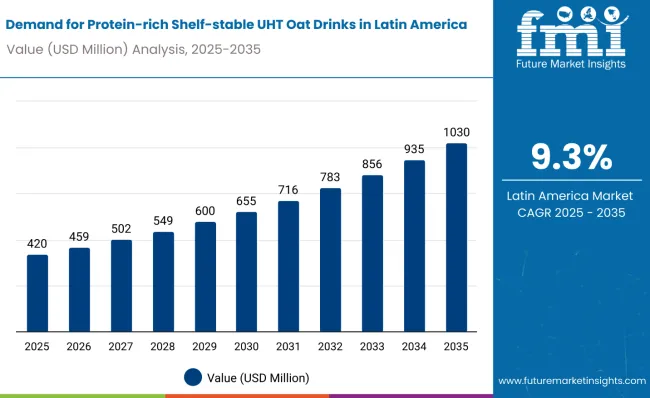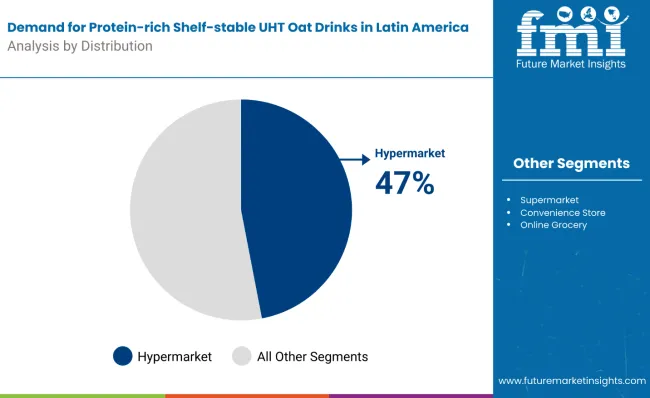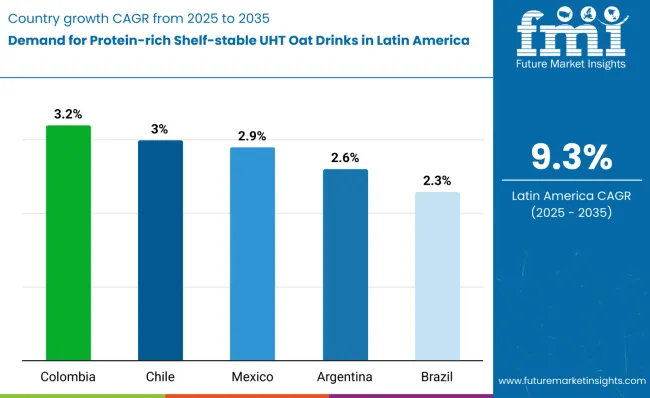Sales of protein-rich shelf-stable UHT oat drinks in Latin America are estimated at USD 420 million in 2025, with projections indicating a rise to USD 1030 million by 2035, reflecting a CAGR of approximately 9.3% over the forecast period.

| Metric | Value |
|---|---|
| Industry Size (2025E) | USD 420 million |
| Industry Value (2035F) | USD 1030 million |
| CAGR (2025 to 2035) | 9.3% |
This growth reflects both a broadening consumer base and increased per capita consumption in key urban centres across the region. The rise in demand is linked to shifting dietary preferences, growing awareness of plant-based nutrition, and evolving convenience trends. By 2025, per capita consumption in leading Latin American countries such as Brazil, Mexico, and Argentina averages between 0.8 to 1.1 liters, with projections reaching 1.7 liters by 2035. São Paulo leads among metropolitan areas, expected to generate USD 187 million in protein-rich UHT oat drink sales by 2035, followed by Mexico City (USD 142 million), Buenos Aires (USD 89 million), Lima (USD 67 million), and Bogotá (USD 54 million).
The largest contribution to demand continues to come from pea protein-enriched oat formulations, which are expected to account for 61% of total sales in 2025, owing to superior amino acid profiles, neutral taste characteristics, and clean label appeal. By distribution channel, hypermarkets represent the dominant retail format, responsible for 47% of all sales, while convenience stores and online platforms are expanding rapidly.
Consumer adoption is particularly concentrated among health-conscious urban professionals and active millennials, with income and urbanization emerging as significant drivers of demand. While price remains a limiting factor, the average price premium over conventional dairy protein drinks has declined from 28% in 2020 to 19% in 2025. Continued improvements in manufacturing scale and regional production facilities are expected to accelerate affordability and access across middle-income households. Regional disparities persist, but per capita demand in high-growth cities like Medellín and Santiago is narrowing the gap with traditionally strong metropolitan centers.
The protein-rich shelf-stable UHT oat drinks segment in Latin America is classified across several segments. By protein source, the key categories include pea protein, soy protein, hemp protein, and blended formulations. By distribution channel, the segment spans hypermarkets, supermarkets, convenience stores, online grocery platforms, and specialty health stores. By packaging format, formulations include 1-liter cartons, 250ml single-serve, 500ml family size, and multi-pack configurations.
By consumer profile, the segment covers health-conscious millennials, fitness enthusiasts, lactose-intolerant consumers, busy urban professionals, and environmentally-aware families. By region, countries such as Brazil, Mexico, Argentina, Chile, and Colombia are included, along with coverage across 15+ Latin American nations. By city, key metro areas analyzed include São Paulo, Mexico City, Buenos Aires, Lima, and Bogotá.

Pea protein formulations are projected to dominate sales in 2025, supported by superior nutritional profiles, allergen-free positioning, and consumer acceptance. Other protein sources such as soy, hemp, and blended options are growing steadily, each serving distinct nutritional needs.

Protein-rich UHT oat drinks in Latin America are distributed through a mix of modern retail and traditional sales channels. Hypermarkets are expected to remain the primary point of sale in 2025, followed by supermarkets and convenience stores. Distribution strategies are evolving to match consumer shopping behavior, with growth coming from both large-format and proximity retail.
Protein-rich UHT oat drinks in Latin America utilize various packaging formats, selected for convenience, price positioning, and consumption occasions. 1-liter cartons remain the most widely adopted format, though single-serve options are gaining momentum. Package developers are increasingly exploring sustainable materials and portion-controlled formats to meet evolving consumer demands.
The protein-rich UHT oat drinks category appeals to a diverse consumer base across age groups, income levels, and lifestyle preferences. While motivations vary from fitness to health to convenience, demand is concentrated among five key demographic clusters. Each group brings distinct purchase behaviors, channel preferences, and product expectations.

Protein-rich UHT oat drink sales will not grow uniformly across every metro area. Rising urbanization and faster per-capita adoption in emerging cities give Medellín and Santiago a measurable edge, while mature metropolitan hubs such as São Paulo expand more steadily from a higher base. The table below shows the compound annual growth rate (CAGR) each of the five largest cities is expected to record between 2025 and 2035.
Between 2025 and 2035, demand for protein-rich UHT oat drinks is projected to expand across all major Latin American metropolitan areas, but the pace of growth will vary based on demographic shifts, retail penetration, and baseline consumption levels. Among the top five cities analyzed, Medellín and Santiago are expected to register the fastest compound annual growth rate (CAGR) of 3.1%, outpacing more mature urban centers.
This acceleration is underpinned by a combination of factors: growing middle-class populations, increasing health awareness, and expanding availability of functional beverages across modern retail formats. In both cities, per capita consumption is projected to rise from 0.9 liters in 2025 to 1.5 liters by 2035, closing the gap with higher-consumption cities such as São Paulo and Mexico City. Retail assortment is also expanding faster in these regions, with new protein formulations and packaging formats gaining traction in hypermarkets and convenience chains.
Lima and Buenos Aires are each forecast to grow at a CAGR of 2.8% over the same period. Both cities already maintain established retail ecosystems, with widespread access to protein-enriched beverages in supermarkets, health stores, and modern convenience formats. In Lima, growth is supported by increasing disposable income, health consciousness, and growing acceptance of plant-based alternatives. Buenos Aires reflects similar dynamics, particularly among fitness-conscious consumers and households seeking functional nutrition options. In both cities, per capita consumption is projected to increase from 1.0 liters in 2025 to 1.6 liters by 2035, reflecting mainstreaming of protein-rich plant-based beverages.
São Paulo, while maintaining the highest overall sales in absolute terms, is expected to grow at a CAGR of 2.4%, slightly below its emerging counterparts. The city already exhibits higher-than-average per capita intake (1.2 liters in 2025), extensive product saturation, and a dense retail network. Growth will likely come from premium formulations, new protein blends, and expanded consumption occasions rather than first-time trial.
Collectively, these five metro areas represent the core of urban demand for protein-rich UHT oat drinks in Latin America, but their individual growth paths highlight the importance of regional tailoring in pricing, formulation development, and channel strategy.

The competitive environment is characterized by a mix of multinational beverage corporations and regional plant-based specialists. Distribution breadth rather than product innovation alone remains the decisive success factor: the five largest suppliers collectively reach more than 25,000 retail outlets across the region and account for a majority of ambient beverage shelf facings in the category.
Alpro, owned by Danone, leverages its European plant-based expertise and Danone's established distribution network to place protein-enriched oat drinks in premium supermarkets and health-focused retail across major Latin American cities. The brand's focus on nutritional superiority and clean-label positioning has allowed Alpro to command premium pricing while building strong repeat purchase rates among health-conscious consumers.
Oatly has established direct operations in Brazil and Mexico, utilizing its global brand recognition and sustainability messaging to penetrate urban markets through specialty coffee chains and premium retail. Recent investments in regional production facilities have improved cost competitiveness and supply chain reliability.
NotCo, the Santiago-based food tech company, applies artificial intelligence to optimize protein-rich plant-based formulations specifically for Latin American taste preferences. The company's regional focus and local manufacturing provide advantages in cost positioning and cultural adaptation, particularly in Chile, Argentina, and Colombia.
Nestlé operates through its plant-based portfolio, introducing protein-enriched oat varieties under regional brand adaptations. The company benefits from extensive ambient beverage distribution infrastructure and co-manufacturing capabilities across multiple Latin American countries.
Unilever competes through acquired brands and private-label partnerships, focusing on accessible pricing and mass-retail penetration. Recent launches emphasize functional benefits and convenient packaging for busy urban lifestyles.
Regional players and private-label programs at major retailers like Walmart (Great Value), Carrefour (Carrefour Bio), and local chains are expanding assortment at price points 15-20% below international brands, creating competitive pressure while supporting category growth. Consolidation activity is expected to continue as distribution scale and local production capabilities become critical for maintaining shelf presence and promotional frequency in this rapidly evolving category.
| Attribute | Details |
|---|---|
| Study Coverage | Latin America sales and consumption of protein-rich shelf-stable UHT oat drinks from 2020 to 2035 |
| Base Year | 2025 |
| Historical Data | 2020 |
| Forecast Period | 2025-2035 |
| Units of Measurement | USD (sales), Million Liters (volume), Liters per capita (consumption) |
| Geography Covered | 15+ Latin American countries; country-level and city-level granularity |
| Top Countries Analyzed | Brazil, Mexico, Argentina, Chile, Colombia, Peru, Venezuela |
| Top Cities Analyzed | São Paulo, Mexico City, Buenos Aires, Lima, Bogotá and 25+ |
| By Protein Source | Pea protein, Soy protein, Hemp protein, Blended formulations |
| By Distribution Channel | Hypermarkets, Supermarkets, Convenience stores, Online grocery, Health stores |
| By Packaging Format | 1-liter cartons, 250ml single-serve, 500ml family size, Multi-pack |
| By Consumer Profile | Health-conscious millennials, Fitness enthusiasts, Lactose-intolerant consumers, Urban professionals, Eco-aware families |
| Metrics Provided | Sales (USD), Volume (ML), Per capita consumption (L), CAGR (2025-2035), Share by segment |
| Price Analysis | Average unit prices by protein source and region |
| Competitive Landscape | Company profiles, private label strategies, regional vs. multinational presence |
| Forecast Drivers | Per capita demand trends, channel expansion, protein awareness, urbanization |
By 2035, total Latin America sales of protein-rich UHT oat drinks are projected to reach USD 1030 million, up from USD 420 million in 2025, reflecting a CAGR of approximately 9.3%.
Pea protein formulations hold the leading share, accounting for approximately 61% of total sales in 2025, followed by soy protein and hemp protein variants.
Medellín and Santiago lead in projected growth, each registering a CAGR of 3.1% between 2025 and 2035, due to urbanization and expanding health awareness.
Hypermarkets are the dominant sales channel (47% share in 2025), but convenience stores and online platforms are growing at double-digit CAGR, especially in urban regions.
Major players include Alpro (Danone), Oatly, NotCo, Nestlé, and Unilever, with growing competition from private label brands like Carrefour Bio and Great Value (Walmart).






Our Research Products

The "Full Research Suite" delivers actionable market intel, deep dives on markets or technologies, so clients act faster, cut risk, and unlock growth.

The Leaderboard benchmarks and ranks top vendors, classifying them as Established Leaders, Leading Challengers, or Disruptors & Challengers.

Locates where complements amplify value and substitutes erode it, forecasting net impact by horizon

We deliver granular, decision-grade intel: market sizing, 5-year forecasts, pricing, adoption, usage, revenue, and operational KPIs—plus competitor tracking, regulation, and value chains—across 60 countries broadly.

Spot the shifts before they hit your P&L. We track inflection points, adoption curves, pricing moves, and ecosystem plays to show where demand is heading, why it is changing, and what to do next across high-growth markets and disruptive tech

Real-time reads of user behavior. We track shifting priorities, perceptions of today’s and next-gen services, and provider experience, then pace how fast tech moves from trial to adoption, blending buyer, consumer, and channel inputs with social signals (#WhySwitch, #UX).

Partner with our analyst team to build a custom report designed around your business priorities. From analysing market trends to assessing competitors or crafting bespoke datasets, we tailor insights to your needs.
Supplier Intelligence
Discovery & Profiling
Capacity & Footprint
Performance & Risk
Compliance & Governance
Commercial Readiness
Who Supplies Whom
Scorecards & Shortlists
Playbooks & Docs
Category Intelligence
Definition & Scope
Demand & Use Cases
Cost Drivers
Market Structure
Supply Chain Map
Trade & Policy
Operating Norms
Deliverables
Buyer Intelligence
Account Basics
Spend & Scope
Procurement Model
Vendor Requirements
Terms & Policies
Entry Strategy
Pain Points & Triggers
Outputs
Pricing Analysis
Benchmarks
Trends
Should-Cost
Indexation
Landed Cost
Commercial Terms
Deliverables
Brand Analysis
Positioning & Value Prop
Share & Presence
Customer Evidence
Go-to-Market
Digital & Reputation
Compliance & Trust
KPIs & Gaps
Outputs
Full Research Suite comprises of:
Market outlook & trends analysis
Interviews & case studies
Strategic recommendations
Vendor profiles & capabilities analysis
5-year forecasts
8 regions and 60+ country-level data splits
Market segment data splits
12 months of continuous data updates
DELIVERED AS:
PDF EXCEL ONLINE
Demand Signal Repository Solutions Market Size and Share Forecast Outlook 2025 to 2035
Demand Side Management Market Size and Share Forecast Outlook 2025 to 2035
Demand Response Market Analysis - Size, Share, and Forecast Outlook 2025 to 2035
North America Shipping Supplies Market Trends – Innovations & Growth 2024-2034
Demand of Kozani Saffron in Greece Analysis - Size, Share & Forecast 2025 to 2035
Demand of No-acid Whey Strained Dairy Processing Concepts in European Union Size and Share Forecast Outlook 2025 to 2035
Demand for Bronte Pistachio in Italy Analysis - Size, Share & Forecast 2025 to 2035
Demand and Trend Analysis of Gaming Monitor in Western Europe Size and Share Forecast Outlook 2025 to 2035
Demand and Trend Analysis of Gaming Monitor in Japan Size and Share Forecast Outlook 2025 to 2035
Demand and Trend Analysis of Gaming Monitor in Korea Size and Share Forecast Outlook 2025 to 2035
Glycine Soja (Soybean) Seed Extract Market Size and Share Forecast Outlook 2025 to 2035
Demand and Trend Analysis of Yeast in Japan - Size, Share, and Forecast Outlook 2025 to 2035
Demand and Trends Analysis of Stevia in Japan Size and Share Forecast Outlook 2025 to 2035
Demand of Pistachio-based desserts & ingredients in France Analysis - Size, Share & Forecast 2025 to 2035
Japan Women’s Intimate Care Market Trends – Growth & Forecast 2024-2034
Western Europe Men’s Skincare Market Analysis – Forecast 2023-2033
Demand and Trend Analysis of Fabric Stain Remover in Korea Size and Share Forecast Outlook 2025 to 2035
Demand and Sales Analysis of Paper Cup in Japan Size and Share Forecast Outlook 2025 to 2035
Demand and Sales Analysis of Paper Cup in Korea Size and Share Forecast Outlook 2025 to 2035
Demand and Sales Analysis of Paper Cup in Western Europe Size and Share Forecast Outlook 2025 to 2035

Thank you!
You will receive an email from our Business Development Manager. Please be sure to check your SPAM/JUNK folder too.
Chat With
MaRIA